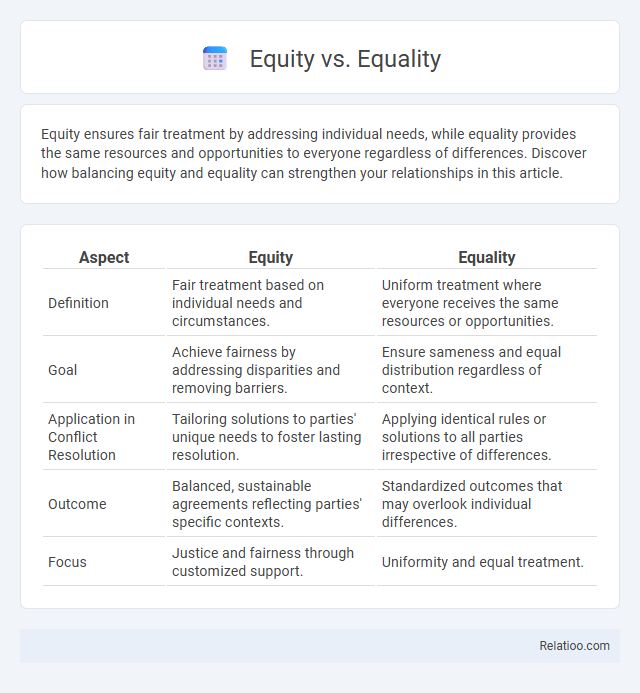Equity ensures fair treatment by addressing individual needs, while equality provides the same resources and opportunities to everyone regardless of differences. Discover how balancing equity and equality can strengthen your relationships in this article.
Table of Comparison
| Aspect | Equity | Equality |
|---|---|---|
| Definition | Fair treatment based on individual needs and circumstances. | Uniform treatment where everyone receives the same resources or opportunities. |
| Goal | Achieve fairness by addressing disparities and removing barriers. | Ensure sameness and equal distribution regardless of context. |
| Application in Conflict Resolution | Tailoring solutions to parties' unique needs to foster lasting resolution. | Applying identical rules or solutions to all parties irrespective of differences. |
| Outcome | Balanced, sustainable agreements reflecting parties' specific contexts. | Standardized outcomes that may overlook individual differences. |
| Focus | Justice and fairness through customized support. | Uniformity and equal treatment. |
Introduction to Equity and Equality
Equity involves recognizing individual differences and distributing resources based on specific needs to achieve fairness, while equality means providing the same resources or opportunities to everyone regardless of their circumstances. Equity aims to level the playing field by addressing systemic barriers, whereas equality focuses on uniform treatment without considering disparities. Understanding these concepts is crucial for developing policies and practices that promote social justice and inclusion.
Defining Equity: Meaning and Principles
Equity involves recognizing individual differences and allocating resources based on needs to achieve fair outcomes, contrasting with equality, which emphasizes uniform distribution regardless of circumstance. The principle of equity prioritizes justice by addressing systemic inequalities and ensuring that marginalized groups receive tailored support to access opportunities. This approach fosters inclusivity by balancing disparities and promoting social and economic fairness across diverse populations.
Understanding Equality: Key Concepts
Understanding equality involves ensuring that every individual has access to the same opportunities and resources, regardless of their background or circumstances. Unlike equity, which tailors support based on individual needs to achieve fairness, equality emphasizes uniform distribution without adjusting for differences. Your approach to fostering inclusive environments should prioritize equality by promoting equal rights and chances for all people.
Historical Context of Equity vs Equality
Equity and equality have distinct historical roots shaping social justice movements, with equality emerging from Enlightenment ideals advocating equal rights and opportunities for all individuals. Equity developed later as a response to persistent disparities, emphasizing fairness by accounting for different circumstances and systemic barriers affecting marginalized groups throughout history. Understanding the historical context of these concepts helps you recognize why equitable policies often replace equal treatment to achieve true social justice.
Key Differences Between Equity and Equality
Equity involves providing resources based on individual needs to achieve fair outcomes, while equality means offering the same resources or opportunities to everyone regardless of their circumstances. Your understanding of equity emphasizes tailored support that addresses systemic barriers, whereas equality assumes a uniform approach suffices for all. Recognizing this distinction is crucial for creating effective policies that promote fairness and inclusion.
The Role of Equity and Equality in Education
Equity in education ensures that Your students receive resources and support tailored to their unique needs, promoting fair opportunities for success. Equality focuses on providing the same resources and opportunities to all students, regardless of their backgrounds or challenges. Balancing both equity and equality helps create an inclusive educational environment where every learner can thrive.
Impacts on Workplace Diversity and Inclusion
Equity in the workplace ensures fair treatment by addressing individual needs and systemic barriers, fostering genuine inclusion and diverse representation. Equality promotes uniform access to opportunities but may overlook unique challenges faced by marginalized groups, potentially limiting true diversity. Your organization's commitment to equity over mere equality drives meaningful workplace diversity and inclusion, enhancing collaboration and innovation.
Social Justice: Equity vs Equality in Practice
Equity in social justice means allocating resources and opportunities based on individual needs to achieve fair outcomes, whereas equality involves providing the same resources irrespective of differing circumstances. Your organization can promote social justice more effectively by adopting equity-focused policies that address systemic barriers and disparities faced by marginalized groups. Understanding the distinction between equity and equality helps create inclusive environments where true fairness and empowerment are realized.
Challenges and Misconceptions
Equity addresses the unique needs and barriers individuals face by providing tailored resources, while equality aims to distribute resources uniformly without considering different circumstances, often leading to ineffective outcomes. Common misconceptions confuse equity with preferential treatment, overlooking that equity seeks fairness through individualized support rather than identical distribution. Understanding these distinctions is crucial for Your organization to overcome challenges in implementing inclusive policies that genuinely promote justice and opportunity.
Building a Fair Society: Equity and Equality Solutions
Building a fair society requires distinguishing between equity, equality, and equity-based solutions, where equity involves addressing individual needs and systemic barriers, while equality ensures uniform access and opportunities for all. Your focus on equity-driven strategies fosters targeted resource allocation, enhancing social justice and reducing disparities. Implementing both approaches in complementary ways promotes inclusivity and sustainable societal progress.

Infographic: Equity vs Equality
 relatioo.com
relatioo.com